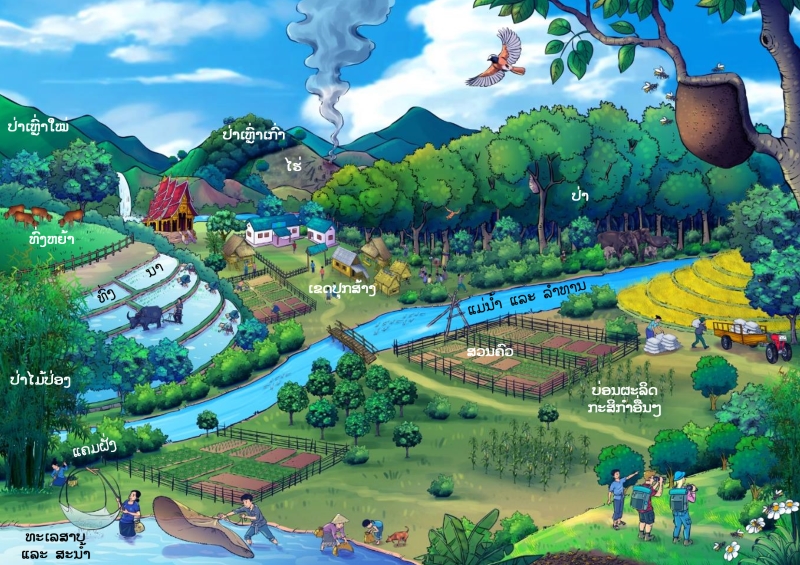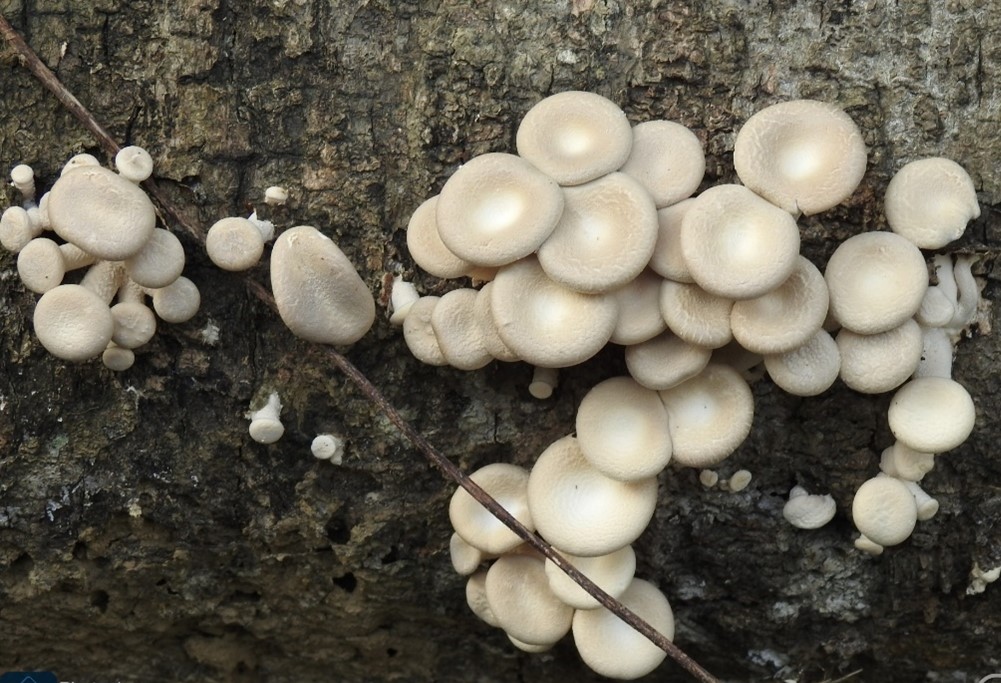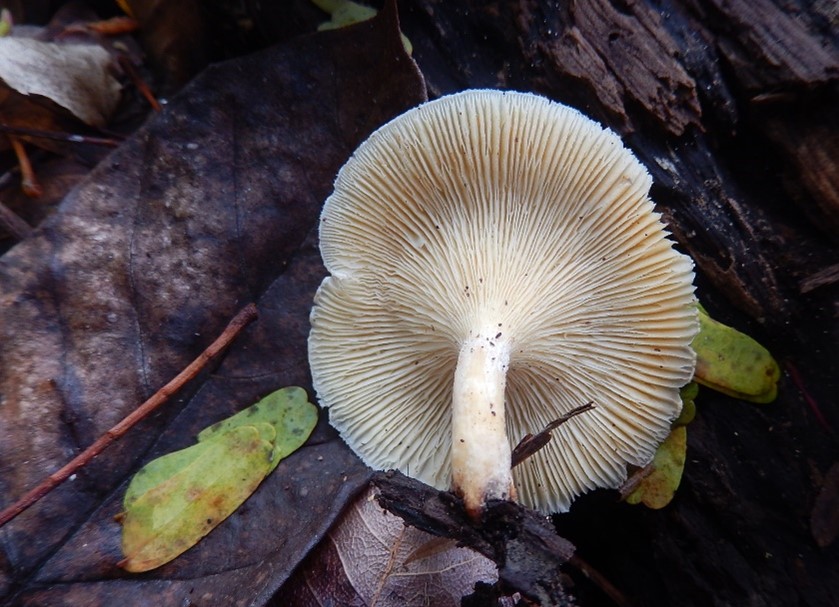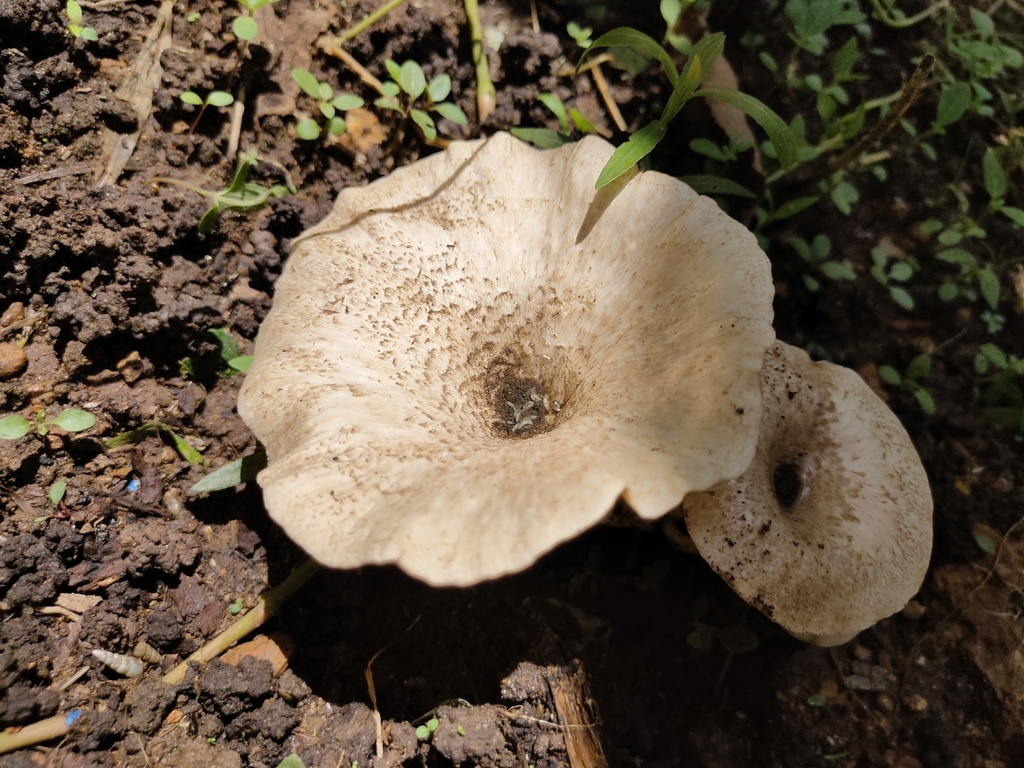ເລກລຳດັບທີ: 125
ລະດັບການຮວບຮວມຂໍ້ມູນ: ຂໍ້ມູນລະອຽດ
ປັບປູງຄັ້ງລ່າສຸດ: 2024-10-11
ເຫັດຂອນຂາວ
White Log Mushroom
Lentinus squarrosulus Mont.
ເຊື້ອເຫັດ
ເຊື້ອຣາເກີດຕາມໄມ້
×
ຊື່ທ້ອງຖີ່ນ:
ເຫັດຂອນຂາວ, ເຫັດກະດ້າງ
ຊື່ພ້ອງ
:
Lentinus squarrosulus Mont.
Lentinus bavianus Pat.
Lentinus caespitosus Curr.
Lentinus crenulatus Massee
Lentinus cretaceus Berk. & Broome
Lentinus curreyanus Sacc. & Cub.
Lentinus hygrometricus Berk.
Lentinus inconspicuus Berk.
Lentinus leucochrous Lév.
Lentinus lobatus Berk. & Broome
Lentinus manipularis Berk. & Broome
Lentinus melanopus Pat.
Lentinus molliceps Fr.
Lentinus bavianus Pat.
Lentinus caespitosus Curr.
Lentinus crenulatus Massee
Lentinus cretaceus Berk. & Broome
Lentinus curreyanus Sacc. & Cub.
Lentinus hygrometricus Berk.
Lentinus inconspicuus Berk.
Lentinus leucochrous Lév.
Lentinus lobatus Berk. & Broome
Lentinus manipularis Berk. & Broome
Lentinus melanopus Pat.
Lentinus molliceps Fr.
ຊື່ສະກຸນ:
Polyporaceae
ຊະນິດໃກ້ຄຽງ:
ເຫັດບົດ/ Tiger Lentinus
ເຫັດຂອນຂາວ/ White Log Mushroom
ເຫັດຫອມ/ Shiitake mushroom
ເຫັດຂອນດອກ / Khon Dok mushroom
ເຫັດໂຕ່ງຝົນໃຫຍ່ / Swine’s stomach mushroom
ເຫັດຂອນຂາວ/ White Log Mushroom
ເຫັດຫອມ/ Shiitake mushroom
ເຫັດຂອນດອກ / Khon Dok mushroom
ເຫັດໂຕ່ງຝົນໃຫຍ່ / Swine’s stomach mushroom
ບັນຍາຍລັກສະນະທາງພືດສາດ:
ເຫັດຊະນິດນີ້ມີລັກສະນະພິເສດ ຄື ມີໃບງຸມລົງ, ມີຂະໜາດຂະໜາດເສັ້ນຜ່າສູນກາງຢູ່ທີ່ 20-60 ມມ ແລະ ກ້ານຂະໜາດ 10-20 x 2-5 ມມ, ຕັ້ງຊື່, ມີເນື້ອບາງ, ໃນໄລ່ຍະທຳອິດຈະມີສີຈາງຫຼາຍ ເຖິງສີຂາວແກມສີຄີມ, ມີຂອບໃບບາງ ແລະ ເຫງືອກແໜ້ນເຊື່ອມກັບກ້ານ, ຂອບໃບລຽບ, ບໍ່ເປັນແສກ, ທັງໝວກ ແລະ ກ້ານຈະມີເກັດຂະໜາດນ້ອຍກະຈາຍຢູ່ທົ່ວໃນໄລ່ຍະອ່ອນ ຂື້ນກັບລັກສະນະທາງສັນຖານວິທະຍາທີ່ແຕກຕ່າງກັນ.
ແຫຼ່ງທີ່ມາ: [4]
ແຫຼ່ງທີ່ມາ: [4]
ນິເວດວິທະຍາ
ເຂດກະຈາຍພັນທົ່ວໂລກ:
L. squarrosulus is regarded as a common paleotropical species, extending throughout equatorial Africa, Southeast Asia, the Pacific islands, and Australasia
ເຂດກະຈາຍພັນໃນລາວ
:
ເຂດພູສູງພາກເໜືອຂອງລາວ
ລຽບແມ່ນ້ຳຂອງພາກເໜືອ
ເຂດພູສູງສາຍພູຫຼວງ ແລະ ເຂດພູພຽງແຂວງຊຽງຂວາງ
ລຽບແມ່ນ້ຳຂອງພາກເໜືອ
ເຂດພູສູງສາຍພູຫຼວງ ແລະ ເຂດພູພຽງແຂວງຊຽງຂວາງ

ເຂດກະຈາຍພັນຕາມພູມສັນຖານ
:
ປ່າປູກ
ປ່າດົງດິບ
ປ່າປະສົມປ່ຽນໃບ
ປ່າແປກ
ປ່າແປກປະສົມປ່າໃບກ້ວາງ
ປ່າເຫຼົ່າອ່ອນ
ປ່າເຫຼົ່າແກ່
ເຂດກະສິກຳອື່ນໆ
ປ່າດົງດິບ
ປ່າປະສົມປ່ຽນໃບ
ປ່າແປກ
ປ່າແປກປະສົມປ່າໃບກ້ວາງ
ປ່າເຫຼົ່າອ່ອນ
ປ່າເຫຼົ່າແກ່
ເຂດກະສິກຳອື່ນໆ

ສະເພາະຖິ່ນໃນລາວ:
ສະເພາະຖິ່ນໃນລາວ
ຮຸກຮານ
:
ບໍ່ຮຸກຮານ
ສະຖານະພາບການອະນູຮັກ IUCN
:
ບໍ່ມີຄວາມສ່ຽງ
ສະຖານະພາບການອະນຸຮັກແຫ່ງຊາດລາວ
:
ບໍ່ຖືກລະບຸໃນບັນຊີປະເພດໃດ
ການນຳໃຊ້
ປະເພດການນຳໃຊ້:
ອາຫານ
ພືດເປັນຢາ
ພືດເປັນຢາ
ບັນຍາຍການນຳໃຊ້:
ອາຫານ: ເປັນເຫັດຊະນິດໜຶ່ງທີ່ຄົນລາວນິຍົມນຳມາປຸ່ງແຕ່ງອາຫານ ໂດຍນຳໄປຕາກແຫ້ງ ແລະ ນຳໄປປີ້ງໃນໃບຕອງ, ຕ້ອງປຸ່ງໃຫ້ສຸກກ່ອນຮັບປະທານ. [4], [7]
ຢາ: ໄດ້ຖືກນໍາໃຊ້ໃນການປິ່ນປົວບາດແຜໃນກະເພາະອາຫານ, ບັນເທົາອາການເລືອດຈາງ, ຊ່ວຍຫຼຸດຜ່ອນໂອກາດຂອງການມີລູກຍາກໃນຜູ້ຊາຍ ແລະ ຜູ້ຍິງ, ຫຼຸດຜ່ອນຄວາມສ່ຽງຂອງພະຍາດ metabolic. ນອກຈາກນີ້ຍັງມີລາຍງານກ່ຽວກັບສານຕ້ານເຊື້ອຈຸລິນຊີ, ເພີ່ມພູມຄຸ້ມກັນ, ຕ້ານອານຸມູນອິດສະຫຼະ, ຕ້ານມະເຮັງ ແລະ ມີລິດຕ້ານນ້ຳຕານໃນເລືອດສູງ. [6]
ຟາມຕ່າງໆ: ປັດຈຸບັນໄດ້ມີການນຳມາພັດທະນາປູູກໃນຟາມເພື່ອເປັນສິນຄ້າ ແລະ ຕອບສະໜອງຕາມຄວາມຕ້ອງການຂອງຕະຫຼາດ. [8]
ຢາ: ໄດ້ຖືກນໍາໃຊ້ໃນການປິ່ນປົວບາດແຜໃນກະເພາະອາຫານ, ບັນເທົາອາການເລືອດຈາງ, ຊ່ວຍຫຼຸດຜ່ອນໂອກາດຂອງການມີລູກຍາກໃນຜູ້ຊາຍ ແລະ ຜູ້ຍິງ, ຫຼຸດຜ່ອນຄວາມສ່ຽງຂອງພະຍາດ metabolic. ນອກຈາກນີ້ຍັງມີລາຍງານກ່ຽວກັບສານຕ້ານເຊື້ອຈຸລິນຊີ, ເພີ່ມພູມຄຸ້ມກັນ, ຕ້ານອານຸມູນອິດສະຫຼະ, ຕ້ານມະເຮັງ ແລະ ມີລິດຕ້ານນ້ຳຕານໃນເລືອດສູງ. [6]
ຟາມຕ່າງໆ: ປັດຈຸບັນໄດ້ມີການນຳມາພັດທະນາປູູກໃນຟາມເພື່ອເປັນສິນຄ້າ ແລະ ຕອບສະໜອງຕາມຄວາມຕ້ອງການຂອງຕະຫຼາດ. [8]
ການປູກ ການລ້ຽງ:
ປູກ ແລະ ທຳມະຊາດ
ລະດູການເກັບກູ້:
ມິຖຸນາ
ກໍລະກົດ
ສິງຫາ
ກັນຍາ
ຕຸລາ
ກໍລະກົດ
ສິງຫາ
ກັນຍາ
ຕຸລາ
ການຕະຫຼາດ ແລະ ຕ່ອງໂສ້ມູນຄ່າ:
ຜະລິດຕະພັນເຫັດຂອນຂາວສົດ ແລະ ຕາກແດດຖືກຈຳໜ່າຍທັງພາຍໃນ ແລະ ຕ່າງປະເທດ, ສ້າງລາຍຮັບໃຫ້ຊາວກະສິກອນເປັນຈຳນວນຫຼວງຫຼາຍ. [8]
ການຄຸ້ມຄອງຈັດການ
ສະພາບໂດຍລວມ:
ອຸນຫະພູມ: ເຫັດຂາວມັກອາກາດຮ້ອນ ແລະ ຄວາມຊຸ່ມຊື່ນສູງ. ອຸນຫະພູມທີ່ເໝາະສົມສໍາລັບການຈະເລີນເຕີບໂຕຂອງເສັ້ນໄຍແມ່ນປະມານ 28-35 ° C ແລະ ໄລຍະເວລາອອກດອກຕ້ອງການອຸນຫະພູມ 35-38 ° C ແລະ ຄວາມຊຸ່ມສຳພັດຢູ່ທີ່ 85% -90%. [9]
ນໍ້າ: ຄວາມຊື້ນຂອງວັດສະດຸປູກຕ້ອງເພີ່ມຂຶ້ນເປັນ 2 ເທົ່າຂອງຄວາມຊື້ນຂອງວັດສະດຸປູກ ຫຼື 70%, ລະດັບຄວາມຊຸ່ມຊື່ນໃນອາກາດຄວນຈະສູງກວ່າ 60% ແຕ່ບໍ່ຄວນເກີນ 90%, ເພາະວ່າຈະເຮັດໃຫ້ການໄຫຼວຽນຂອງອາກາດມີຄວາມຫຍຸ້ງຍາກ ແລະ ເຫັດຈະດູດຊຶມນ້ໍາຫຼາຍເກີນໄປ. ເພື່ອກະຕຸ້ນໃຫ້ເຫັດອອກດອກ, ຈໍາເປັນຕ້ອງຫຼຸດຜ່ອນຄວາມຊຸ່ມຊື່ນໃຫ້ຕ່ໍາກວ່າ 60%. [9]
ແສງສະຫວ່າງ: ແສງສະຫວ່າງຕ່ໍາແມ່ນເໝາະສົມສໍາລັບການຂະຈະເລີນເຕີບຕົວຂອງເຫັດ, ໂດຍສະເພາະໃນໄລຍະການສ້າງເສັ້ນໄຍ. ສໍາລັບໄລຍະອອກດອກ ແສງຈະຊ່ວຍກະຕຸ້ນດອກເຫັດ ແລະ ການເຕີບໃຫຍ່ຂອງດອກເຫັດ. [9]
pH: ເຫັດຈະເລີນເຕີບໂຕໄດ້ດີໃນອາຫານທີ່ເປັນດ່າງ ຫຼື ເປັນກົດເລັກນ້ອຍ (pH = 6.5-7). ຖ້າອາຫານມີຄວາມເປັນກົດຫຼາຍ ເຫັດຈະມີເສັ້ນໃຍ ແຕ່ຈະບໍ່ອອກດອກ ຫຼື ອອກດອກໜ້ອຍ. ຄ່າ pH ຂອງນ້ໍາທີ່ໃຊ້ສໍາລັບການຊົນລະປະທານແມ່ນເຫມາະສົມ (pH = 7). ມັນຕ້ອງສະອາດ ແລະ ປາສະຈາກສານເຄມີ. [9]
ການໄຫຼວຽນຂອງອາກາດ: ໄລຍະອອກດອກຂອງເຫັດມີຄວາມຕ້ອງການອົກຊີເຈນຫຼາຍກ່ວາໄລຍະເສັ້ນໄຍ. ຄາບອນໄດອອກໄຊ (CO2) ຈະເຮັດໃຫ້ເສັ້ນໃຍຈະເລີນເຕີບໂຕ ແຕ່ຖ້າບໍ່ມີການໄຫຼວຽນຂອງອາກາດໃນຊ່ວງເວລາອອກດອກໃນໂຮງເຮືອນ, ຈະເຮັດໃຫ້ເຫັດບໍ່ອອກດອກ, ດອກນ້ອຍ ແລະ ກ້ານດອກຍາວຜິດປົກກະຕິ [9]
ການຄັດເລືອກສາຍພັນ:
ສໍາລັບການຜະລິດທີ່ເໝາະສົມ, ມັນຈໍາເປັນຕ້ອງເລືອກແນວພັນທີ່ດີ, ມີຄຸນນະພາບສູງ, ຜົນຜະລິດສູງ, ທົນທານຕໍ່ພະຍາດໄດ້ດີ ແລະ ສາມາດປັບຕົວເຂົ້າກັບສະພາບແວດລ້ອມ, ລະດູການ ແລະ ພື້ນທີ່ໄດ້ດີ. ສາມາດນຳມາປູກເຫັດໃສ່ ແລະ ຂີ້ເລື່ອຍຈາກຕົ້ນໄມ້ຕ່າງໆໄດ້. [9]
ການກຽມພື້ນທີ່:
ສະຖານທີ່: ໂຮງເຮືອນຄວນຢູ່ໃນບ່ອນທີ່ມີອາກາດທາຍເທດີ, ບໍ່ມີລົມແຮງ ແລະ ບໍ່ມີນໍ້າຖ້ວມ, ຄວນຈະຢູ່ຫ່າງຈາກຄອກສັດ. [9]
ການອອກແບບ: ເຮືອນແກ້ວຄວນຖືກອອກແບບເພື່ອຫຼຸດແສງຕາເວັນໃຫ້ໜ້ອຍທີ່ສຸດ. ດ້ານໜ້າຂອງເຮືອນແກ້ວຄວນປະເຊີນກັບທິດຕາເວັນອອກສໍາລັບການລະບາຍອາກາດ, ແລະ ຄວນໄດ້ຮັບການປົກຫຸ້ມດ້ວຍຫຍ້າເພື່ອຊ່ວຍ insulate ມັນ. ໂຮງເຮືອນສຳລັບປູກເຫັດມີ 2 ປະເພດຫຼັກ ຄື: ໂຮງເຮືອນປິດ ແລະ ແບບໂຮງເຮືອນເປີດ. [9]
ການກຽມຂີ້ເລືອຍ: ຂີ້ເລື່ອຍທີ່ໃຊ້ໃນການປູກເຫັດຕ້ອງແຫ້ງ, ຖ້າໃຊ້ຂີ້ເລື່ອຍສົດ ຕ້ອງປະໄວ້ 1 ອາທິດ, ໝັກດ້ວຍປູນຂາວ 1 ອາທິດ ຫຼື ຫຼາຍກວ່ານັ້ນ. ອາດຈະຕື່ມສ່ວນປະກອບອື່ນໆເຂົ້າໃນຂີ້ເລື່ອຍ. ແລະ ເພື່ອໝັກຂີ້ເລື່ອຍ ຄວນກວດສອບໃຫ້ແນ່ໃຈວ່າບໍ່ມີເສດໄມ້ປະສົມປົນຢູ່ນຳ. ສ່ວນປະກອບຂອງປູນຂາວແມ່ນ 1% ແລະ ຄວາມຊຸ່ມຊື່ນຂອງຂີ້ເລື່ອຍແມ່ນ 65%. ຖ້າຂີ້ເລື່ອຍແຫ້ງໃຫ້ຕື່ມນ້ໍາເພີ່ມຄວາມຊຸ່ມ. ຄົນສ່ວນປະສົມໃຫ້ເຂົ້າກັນແລ້ວປົກດ້ວຍຜ້າຢາງປຼາສະຕິກປະໄວ້ 1 ເດືອນກ່ອນໃຊ້ງານ. [9] [10]
ເທັກນິກການປູກ:
ການຕີ ແລະ ຕົ້ມ ກ້ອນເຫັດ: ປະສົມກ້ອນເຫັດກັບອາຫານເສີມ, ຂີ້ເລື່ອຍ ຄົນໃຫ້ເຂົ້າກັນ ແລະ ຕື່ມນ້ຳໃຫ້ຊຸ່ມເຖິງ 65%. ເອົາສ່ວນປະສົມໃສ່ໃນຖົງພຼາສຕິກ ແລ້ວຕີໃຫ້ແໜ້ນ, ຂັບໄລ່ອາກາດໂດຍການຈັບປາກຂອງຖົງ ແລະ ວາງໃສ່ຄໍຂອງຂວດ, ດຶງຖົງໃສ່ຄໍຂອງຂວດ ແລ້ວດຶງໃຫ້ແໜ້ນ ຈາກນັ້ນປິດປາກຂວດດ້ວຍສໍາລີ ແລະ ຝາຂວດເພື່ອປ້ອງກັນບໍ່ໃຫ້ນ້ໍາເຂົ້າ. ຂ້າເຊື້ອກ້ອນເຫັດຫ້ອງປອດເຊື້ອ ຫຼື ນຳໄປໜຶ້ງປະມານ 3-4 ຊົ່ວໂມງ. [9] [10]
ການປະສົມ ແລະ ການເຂ່ຍເຊື້ອເຫັດ: ກຽມອຸປະກອນທັງໝົດໃຫ້ພ້ອມແລ້ວສັ່ນຂວດເຊື້ອເຫັດໃຫ້ແຕກອອກຈາກກັນ, ນຳເອົາສຳລີອອກຈາກຂວດ ແລະ ເຊັດປາກຂວດດ້ວຍຜ້າຂົນໜູ, ຈາກນັ້ນນຳເຊື້ອເຫັດໃສ່ໃນກ້ອນທີ່ກຽມໄວ້. [9]
ການເປີດດອກ: ດອກເຫັດຈະເປີດບານພາຍຫຼັງເຂ່ຍເຊື້ອໄດ້ 45 ວັນ ແລະ ຫຼັງຈາກເປີດດອກເຫັດປະມານ 24 ຊົ່ວໂມງ, ດອກເຫັດຈະໃຫຍ່ພໍທີ່ຈະເກັບກ່ຽວ. [9]
ການເບິ່ງແຍງ ແລະ ບຳລຸງຮັກສາ:
ການດູແລຮັກສາເຫັດຫຼັງການອອກດອກ: ຄວນຫົດນໍ້າເຫັດ ແລະ ໂຮງເຮືອນ 3 ຄັ້ງຕໍ່ມື້, ເຊົ້າ, ຫຼັງທ່ຽງ ແລະ ຕອນແລງ, ເພື່ອຮັກສາຄວາມຊຸ່ມຊື່ນໄວ້ປະມານ 90% ແລະ ອຸນຫະພູມທີ່ເໝາະສົມປະມານ 35-38 ອົງສາ, ເມື່ອເກັບເຫັດແລ້ວຄວນອະນາໄມເຫັດ ແລະ ໂຮງເຮືອນ ເພື່ອປ້ອງກັນສັດຕູພືດ, ພະຍາດ ແລະ ການລົບກວນຈາກສັດ. [9]
ອຸນຫະພູມ: ເຫັດຂາວມັກອາກາດຮ້ອນ ແລະ ຄວາມຊຸ່ມຊື່ນສູງ. ອຸນຫະພູມທີ່ເໝາະສົມສໍາລັບການຈະເລີນເຕີບໂຕຂອງເສັ້ນໄຍແມ່ນປະມານ 28-35 ° C ແລະ ໄລຍະເວລາອອກດອກຕ້ອງການອຸນຫະພູມ 35-38 ° C ແລະ ຄວາມຊຸ່ມສຳພັດຢູ່ທີ່ 85% -90%. [9]
ນໍ້າ: ຄວາມຊື້ນຂອງວັດສະດຸປູກຕ້ອງເພີ່ມຂຶ້ນເປັນ 2 ເທົ່າຂອງຄວາມຊື້ນຂອງວັດສະດຸປູກ ຫຼື 70%, ລະດັບຄວາມຊຸ່ມຊື່ນໃນອາກາດຄວນຈະສູງກວ່າ 60% ແຕ່ບໍ່ຄວນເກີນ 90%, ເພາະວ່າຈະເຮັດໃຫ້ການໄຫຼວຽນຂອງອາກາດມີຄວາມຫຍຸ້ງຍາກ ແລະ ເຫັດຈະດູດຊຶມນ້ໍາຫຼາຍເກີນໄປ. ເພື່ອກະຕຸ້ນໃຫ້ເຫັດອອກດອກ, ຈໍາເປັນຕ້ອງຫຼຸດຜ່ອນຄວາມຊຸ່ມຊື່ນໃຫ້ຕ່ໍາກວ່າ 60%. [9]
ແສງສະຫວ່າງ: ແສງສະຫວ່າງຕ່ໍາແມ່ນເໝາະສົມສໍາລັບການຂະຈະເລີນເຕີບຕົວຂອງເຫັດ, ໂດຍສະເພາະໃນໄລຍະການສ້າງເສັ້ນໄຍ. ສໍາລັບໄລຍະອອກດອກ ແສງຈະຊ່ວຍກະຕຸ້ນດອກເຫັດ ແລະ ການເຕີບໃຫຍ່ຂອງດອກເຫັດ. [9]
pH: ເຫັດຈະເລີນເຕີບໂຕໄດ້ດີໃນອາຫານທີ່ເປັນດ່າງ ຫຼື ເປັນກົດເລັກນ້ອຍ (pH = 6.5-7). ຖ້າອາຫານມີຄວາມເປັນກົດຫຼາຍ ເຫັດຈະມີເສັ້ນໃຍ ແຕ່ຈະບໍ່ອອກດອກ ຫຼື ອອກດອກໜ້ອຍ. ຄ່າ pH ຂອງນ້ໍາທີ່ໃຊ້ສໍາລັບການຊົນລະປະທານແມ່ນເຫມາະສົມ (pH = 7). ມັນຕ້ອງສະອາດ ແລະ ປາສະຈາກສານເຄມີ. [9]
ການໄຫຼວຽນຂອງອາກາດ: ໄລຍະອອກດອກຂອງເຫັດມີຄວາມຕ້ອງການອົກຊີເຈນຫຼາຍກ່ວາໄລຍະເສັ້ນໄຍ. ຄາບອນໄດອອກໄຊ (CO2) ຈະເຮັດໃຫ້ເສັ້ນໃຍຈະເລີນເຕີບໂຕ ແຕ່ຖ້າບໍ່ມີການໄຫຼວຽນຂອງອາກາດໃນຊ່ວງເວລາອອກດອກໃນໂຮງເຮືອນ, ຈະເຮັດໃຫ້ເຫັດບໍ່ອອກດອກ, ດອກນ້ອຍ ແລະ ກ້ານດອກຍາວຜິດປົກກະຕິ [9]
ການຄັດເລືອກສາຍພັນ:
ສໍາລັບການຜະລິດທີ່ເໝາະສົມ, ມັນຈໍາເປັນຕ້ອງເລືອກແນວພັນທີ່ດີ, ມີຄຸນນະພາບສູງ, ຜົນຜະລິດສູງ, ທົນທານຕໍ່ພະຍາດໄດ້ດີ ແລະ ສາມາດປັບຕົວເຂົ້າກັບສະພາບແວດລ້ອມ, ລະດູການ ແລະ ພື້ນທີ່ໄດ້ດີ. ສາມາດນຳມາປູກເຫັດໃສ່ ແລະ ຂີ້ເລື່ອຍຈາກຕົ້ນໄມ້ຕ່າງໆໄດ້. [9]
ການກຽມພື້ນທີ່:
ສະຖານທີ່: ໂຮງເຮືອນຄວນຢູ່ໃນບ່ອນທີ່ມີອາກາດທາຍເທດີ, ບໍ່ມີລົມແຮງ ແລະ ບໍ່ມີນໍ້າຖ້ວມ, ຄວນຈະຢູ່ຫ່າງຈາກຄອກສັດ. [9]
ການອອກແບບ: ເຮືອນແກ້ວຄວນຖືກອອກແບບເພື່ອຫຼຸດແສງຕາເວັນໃຫ້ໜ້ອຍທີ່ສຸດ. ດ້ານໜ້າຂອງເຮືອນແກ້ວຄວນປະເຊີນກັບທິດຕາເວັນອອກສໍາລັບການລະບາຍອາກາດ, ແລະ ຄວນໄດ້ຮັບການປົກຫຸ້ມດ້ວຍຫຍ້າເພື່ອຊ່ວຍ insulate ມັນ. ໂຮງເຮືອນສຳລັບປູກເຫັດມີ 2 ປະເພດຫຼັກ ຄື: ໂຮງເຮືອນປິດ ແລະ ແບບໂຮງເຮືອນເປີດ. [9]
ການກຽມຂີ້ເລືອຍ: ຂີ້ເລື່ອຍທີ່ໃຊ້ໃນການປູກເຫັດຕ້ອງແຫ້ງ, ຖ້າໃຊ້ຂີ້ເລື່ອຍສົດ ຕ້ອງປະໄວ້ 1 ອາທິດ, ໝັກດ້ວຍປູນຂາວ 1 ອາທິດ ຫຼື ຫຼາຍກວ່ານັ້ນ. ອາດຈະຕື່ມສ່ວນປະກອບອື່ນໆເຂົ້າໃນຂີ້ເລື່ອຍ. ແລະ ເພື່ອໝັກຂີ້ເລື່ອຍ ຄວນກວດສອບໃຫ້ແນ່ໃຈວ່າບໍ່ມີເສດໄມ້ປະສົມປົນຢູ່ນຳ. ສ່ວນປະກອບຂອງປູນຂາວແມ່ນ 1% ແລະ ຄວາມຊຸ່ມຊື່ນຂອງຂີ້ເລື່ອຍແມ່ນ 65%. ຖ້າຂີ້ເລື່ອຍແຫ້ງໃຫ້ຕື່ມນ້ໍາເພີ່ມຄວາມຊຸ່ມ. ຄົນສ່ວນປະສົມໃຫ້ເຂົ້າກັນແລ້ວປົກດ້ວຍຜ້າຢາງປຼາສະຕິກປະໄວ້ 1 ເດືອນກ່ອນໃຊ້ງານ. [9] [10]
ເທັກນິກການປູກ:
ການຕີ ແລະ ຕົ້ມ ກ້ອນເຫັດ: ປະສົມກ້ອນເຫັດກັບອາຫານເສີມ, ຂີ້ເລື່ອຍ ຄົນໃຫ້ເຂົ້າກັນ ແລະ ຕື່ມນ້ຳໃຫ້ຊຸ່ມເຖິງ 65%. ເອົາສ່ວນປະສົມໃສ່ໃນຖົງພຼາສຕິກ ແລ້ວຕີໃຫ້ແໜ້ນ, ຂັບໄລ່ອາກາດໂດຍການຈັບປາກຂອງຖົງ ແລະ ວາງໃສ່ຄໍຂອງຂວດ, ດຶງຖົງໃສ່ຄໍຂອງຂວດ ແລ້ວດຶງໃຫ້ແໜ້ນ ຈາກນັ້ນປິດປາກຂວດດ້ວຍສໍາລີ ແລະ ຝາຂວດເພື່ອປ້ອງກັນບໍ່ໃຫ້ນ້ໍາເຂົ້າ. ຂ້າເຊື້ອກ້ອນເຫັດຫ້ອງປອດເຊື້ອ ຫຼື ນຳໄປໜຶ້ງປະມານ 3-4 ຊົ່ວໂມງ. [9] [10]
ການປະສົມ ແລະ ການເຂ່ຍເຊື້ອເຫັດ: ກຽມອຸປະກອນທັງໝົດໃຫ້ພ້ອມແລ້ວສັ່ນຂວດເຊື້ອເຫັດໃຫ້ແຕກອອກຈາກກັນ, ນຳເອົາສຳລີອອກຈາກຂວດ ແລະ ເຊັດປາກຂວດດ້ວຍຜ້າຂົນໜູ, ຈາກນັ້ນນຳເຊື້ອເຫັດໃສ່ໃນກ້ອນທີ່ກຽມໄວ້. [9]
ການເປີດດອກ: ດອກເຫັດຈະເປີດບານພາຍຫຼັງເຂ່ຍເຊື້ອໄດ້ 45 ວັນ ແລະ ຫຼັງຈາກເປີດດອກເຫັດປະມານ 24 ຊົ່ວໂມງ, ດອກເຫັດຈະໃຫຍ່ພໍທີ່ຈະເກັບກ່ຽວ. [9]
ການເບິ່ງແຍງ ແລະ ບຳລຸງຮັກສາ:
ການດູແລຮັກສາເຫັດຫຼັງການອອກດອກ: ຄວນຫົດນໍ້າເຫັດ ແລະ ໂຮງເຮືອນ 3 ຄັ້ງຕໍ່ມື້, ເຊົ້າ, ຫຼັງທ່ຽງ ແລະ ຕອນແລງ, ເພື່ອຮັກສາຄວາມຊຸ່ມຊື່ນໄວ້ປະມານ 90% ແລະ ອຸນຫະພູມທີ່ເໝາະສົມປະມານ 35-38 ອົງສາ, ເມື່ອເກັບເຫັດແລ້ວຄວນອະນາໄມເຫັດ ແລະ ໂຮງເຮືອນ ເພື່ອປ້ອງກັນສັດຕູພືດ, ພະຍາດ ແລະ ການລົບກວນຈາກສັດ. [9]
ໂພຊະນາການ
ຄຸນຄ່າທາງໂພຊະນາການ:
ແຫຼ່ງໂປຣຕີນທີ່ສຳຄັນ
ບັນຍາຍຄຸນຄ່າທາງໂພຊະນາການ:
N/A
| ສານອາຫານ | /100g | ໝາຍເຫດ |
|---|---|---|
| ໂປຣຕີນ | 57.6 | N/A |
| ຄາໂບໄຮເດຣດ | N/A | N/A |
| ໄຂມັນ | 0.5 | N/A |
| ວິຕາມິນ | N/A | ວິຕາມິນ B1 1.42 mg, ວິຕາມິນ B3 194.29 g |
| ແຮ່ທາດ | N/A | ແມັກນີຊ້ຽມ 0.4 g |
| ເສັ້ນໄຍ | N/A | N/A |
ອ້າງອິງ
ເຄດິດຮູບພາບ:
ອ້າງອິງ:
NAFRI, NUoL, SNV. 2007. Non−Timber Forest Products in the Lao PDR. A Manual of 100 Commercial and Traditional Products. The National Agriculture and Forestry Research Institute. Vientiane, Lao PDR
Mortimer, P.E., Xu, J., Karunarathna, S.C. & Hyde, K.D. 2014. Mushrooms for Trees and People. A field guide to useful mushrooms of the Mekong region. The World Agroforestry Centre, East Asia, Kunming, China. (p.12).
Samantha C. Karunarathna et al. 2011. Three new species of Lentinus from northern Thailand. Mycol Progress (2011) 10:389–398.
Zhou S, Tang QJ, Zhang Z, Li CH, Cao H, Yang Y, Zhang JS. 2015. Nutritional Composition of Three Domesticated Culinary-Medicinal Mushrooms: Oudemansiella sudmusida, Lentinus squarrosulus, and Tremella aurantialba.
Mortimer, P.E., Xu, J., Karunarathna, S.C. & Hyde, K.D. 2014. Mushrooms for Trees and People. A field guide to useful mushrooms of the Mekong region. The World Agroforestry Centre, East Asia, Kunming, China. (p.12).
Samantha C. Karunarathna et al. 2011. Three new species of Lentinus from northern Thailand. Mycol Progress (2011) 10:389–398.
Zhou S, Tang QJ, Zhang Z, Li CH, Cao H, Yang Y, Zhang JS. 2015. Nutritional Composition of Three Domesticated Culinary-Medicinal Mushrooms: Oudemansiella sudmusida, Lentinus squarrosulus, and Tremella aurantialba.
ຜູ້ສ້າງ Factsheet:
ຜູ້ກວດສອບ Factsheet:
,


